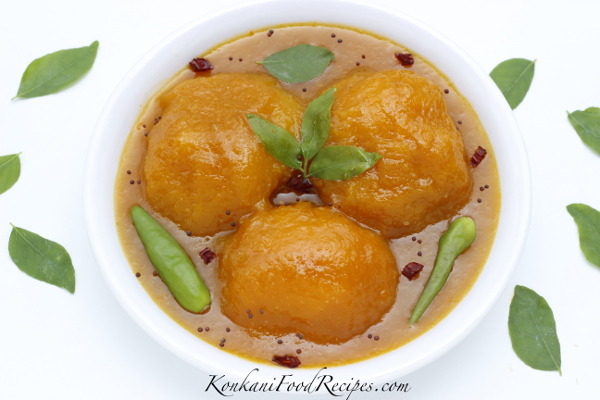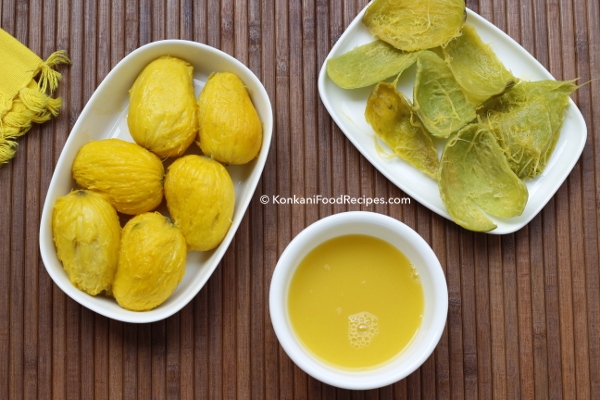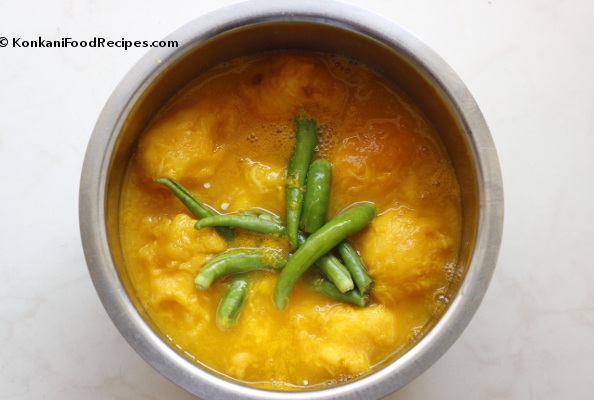Sweet, Sour, Spicy Mango Curry (Ambe Upakari)

Watch ambe upakari making here:
Shorter quick reference:
Come summer and it's mango season in India. That's when Konkani's get onto preparing their favourite mango curry - ambe upakari. Ambe upakari is by far one of the most delicious curry of Konkani cuisine. A sweet, sour, spicy mango curry that is every Konkani's favourite.
A thick gravy is prepared using ripe mangoes, mango pulp, coconut milk, salt & jaggery. It is then seasoned to make a scrumptious curry. The flavourful seasoning adds to the myriad of taste & flavours of this mango curry. Whole mangoes are cooked in a thick coconut milk based delicious curry. Konkani's literally go slurp.. slurp..while eating this delicious mango curry. :) You actually tend to make that noise while eating this fabulous mango curry. It’s that delicious and to die for! All special occasions, celebrations, weddings in summer have this mango curry on the menu and I bet ambe upakari is prepared atleast once every week, in every Konkani home during the mango season.
This phenomenal mango curry is served as a side dish during lunch & dinner. A whole ripe mango & a ladle full of thick gravy is usually what you get served for lunch, dinner as a side dish. Very few actually eat rice with this curry, mix rice with this curry & enjoy. The curry is just devoured by itself by majority of us. The pulpy whole mango in the curry, is first eaten clean by biting into it. Eat this curry with your hands & don't worry if your hands get messy in the process. That's meant to be & that's how it's eaten. :) Then the cleaned out hard mango kernel is used as a spoon to eat rest of the thick, slurpy curry. Or you can use your fingers to slurp-on the delicious gravy.
I sit down with a bowl of this delicious curry and enjoy it with a spoon as my main-course & dessert. Love it so much! :) However to eat the whole ripe mango in the curry, I have to dig in, use my fingers and get them dirty. Also, mind you if the ripe mangoes used are pulpy & hairy then there are chances that you'll have to brush & floss your teeth after your done enjoying this curry. :) But trust me, it's all worth it.
Ambe upakari is usually served steaming hot but it's tastes great when it's cold too. Ambo in Konkani means mango and upakari in Konkani is a spicy, veggie stir fry made using coconut. Hence, the name ambe upakari to this curry in Konkani.
Mangoes used to prepare ambe upakari:
Traditionally, the mangoes used to prepare ambe upakari are the local varieties of mangoes. Mangoes called as "katt ambo/gont ambo/upakari ambo" in Konkani ie, mangoes that grow on backyard mango trees. These are local variety of mangoes, not the cultivated variety with very little pulp in them. These varieties of mango are usually sour-sweet & are perfect to make ambe upakari as they impart their sourness & sweetness to this mango curry to make it delicious. Nothing beats ambe upakari made using these local varieties of mangoes.
Look at their size below. They are very tiny to medium-small in size. The local variety of mangoes below are placed next to considerably small Alphonso mangoes to help you gauge their size.
Sorry, I don’t know the English names of these mangoes. These local variety mangoes are smaller in size, not very juicy, are sour, not-so-sweet & are too hairy on the inside. They are not the tasty mangoes we usually eat and enjoy. This makes me think that our ancestors invented this dish while finding a way to use up these sour, not-so-sweet mangoes that they couldn’t eat. Adding jaggery, green chillies, coconut milk to these not-so-good mangoes in a curry, takes them to a whole new level.
Taste of this curry (ambe upakari) depends on the mangoes you use to make it. However, you can also use sour, not-so-sweet, sour-sweet, sweet mangoes to make ambe upakari. In short, use any kind of ripe mango and adjust the amount of jaggery, green chillies you add accordingly. Ideally, use mangoes that have a lot of pulp in them to make the best ambe upakari. Cook, give this curry a try and then you’ll know why. ;-) You'll then get a nice, thick pulpy delicious gravy. :)
If the mangoes used are sweet, then adjust the amount of jaggery you add according to how sweet you like your ambe upakari. If the mangoes are sour, then you'll have to add lot more of jaggery to the curry to balance out the sourness. Usually, a good mix of sweet and sour mangoes are used, to get the balance right, to make the curry sweet as well as slightly tangy.
If you can't lay hands on any of the mangoes mentioned above, then use any mangoes that are available.
Ingredients:
5-6 ripe mangoes
1/2 cup jaggery
1 cup grated coconut
1 teaspoon of plain flour (maida) or arrowroot powder or 1/4 teaspoon of rice flour
4-5 green chillies
1 dried red chilli
1/2 teaspoon mustard seeds
2 tablespoons of oil
2 leaflets of curry leaves
A pinch of asafoetida powder/crystal asafoetida
Serves: 2-3
Preparation Time: 40 minutes
Preparation Method:
1. Wash the ripe mangoes nicely. Peel the mangoes using your hands, remove just the peel off. If there's any mango pulp sticking to the peel it's ok.
2. Don't discard the peel, add them into a bowl. Add whole pulpy mangoes into another cooking vessel.
3. Once all the mangoes are peeled, add about 1/2-3/4 cup of water to the bowl containing mango peels. Squeeze the peels well using your hands to remove any mango pulp sticking to it.
4. Transfer this water containing little mango pulp into the cooking vessel containing whole mangoes.
5. If the peel still has any mango pulp sticking to it, then add some more water (about 1/4-1/2 cup) to the bowl with the mango peels and repeat the about process. Keep this diluted mango water aside.
6. Give the whole mangoes a good squeeze with your finger tips. Don't remove off the pulp sticking to it. Just a squeeze so that any excess mango pulp comes off the mangoes and gives the curry a nice, pulpy texture. We also need a good amount of mango pulp sticking to the mango kernel, so that you can enjoy eating that too. Another reason behind squeezing the mangoes a little is to aid them take in jaggery & spice well in.
7. Keep the cooking vessel with whole mangoes & a little watery mango pulp, on a medium flame and bring it to boil.
8. Add in slit green chillies, salt, jaggery, 5-6 curry leaves (for extra flavour) and mix well.
Add jaggery depending on the sweetness of the mangoes and how sweet you want your curry (ambe upakari) to be.
Mangoes give out water on cooking, jaggery dissolves in water & further dilutes the gravy.
9. Stir the mangoes once in a while, to prevent them from sticking to the bottom of the vessel.
10. Meanwhile, grind grated coconut using 1/2 cup of water into a smooth paste. Strain the coconut milk and keep it aisde.
11. Once the mangoes are cooked, the colour of the mangoes and green chillies change, add in the concentrated coconut milk kept aside to the boiling mango curry and mix well. Coconut milk gives a nice taste to this mango curry (ambe upakari).
12. Then add in another 1/2 cup of water to the ground-grated coconut & grind it again. Strain this coconut milk. This 2nd coconut milk you get would be diluted. Keep it aside.
13. Add in plain flour/arrow root powder/rice flour to this diluted coconut milk, mix well such that there are no clumps formed. Add it to the boiling curry (ambe upakari) and mix well.
Plain flour/arrow root powder is added to give thickness to the gravy. They thicken the otherwise watery gravy and gives it a nice, thick consistency. The curry will thicken more on cooking and on cooling down further due to the flours added.
Read note at the bottom for other options.
14. Then let the curry simmer for 5-10 minutes with constant stirring. As the curry boils, it starts to thicken. As it cools down, it'll further thicken. So, we need a semi-thick gravy to start with.
15. Add in diluted mango water kept aside in step 5 if required & mix well. Be careful as to not add excess water. We do not want a diluted, watery curry. This mango curry (ambe upakari) tastes best when it's thick in consistency.
If the mangoes give out too much water on cooking and the curry becomes watery, then you can thicken it by adding some more plain flour/arrow root powder (a tablespoon) dissolved in 3 tablespoons of water. Be careful not to add excess of these flours as they meddle with the taste of the curry.
16. Dissolve a pinch of crystal asafoetida in water and add it to the curry, mix well. Check & adjust salt, sweetness & spice.
17. Once the curry is cooked through, the rawness of the flours, mangoes has gone off, once the ingredients have blend in together & the curry has thickened, remove the curry off heat.
18. The gravy shoul be semi thick in consistency, not too thick nor too thin in the end.
Tempering the curry:
18. Heat oil in a tempering pan, add in mustard seeds. Once they start popping, add in curry leaves, small pieces of dried red chillies and fry them for few seconds. Remove it off heat, add it to the gravy and mix well.
Serving Suggestion:
Serve ambe upakari with rice and enjoy. Ambe upakari is served as a side dish with rice for lunch & dinner or can be eaten as-is. We enjoy it as a dessert & go SLURP... SLURP... and enjoy!
Note:
1. We at home use arrow root powder instead of the plain flour to make this mango curry (ambe upakari) all the more healthy. Just to avoid the refined plain flour. In case you're using arrow root powder, give it a nice wash, decant the water and then mix the powder well with 1/2 cup of diluted coconut milk and then add it to the curry.
2. Some even add finely ground grated coconut directly to the curry to thicken it. But that meddles with the taste of the mango curry (ambe upakari) if coconut is not ground very well. We at home prefer adding coconut milk to finely ground grated coconut. If coconut becomes very smooth in texture then can be added to ambe upakari directly.
3. You can also add corn flour.
4. You can also add few rice grains (1/4 teaspoon) to grated coconut while grinding it.
My favourite is using arrow root powder (kathre peet in Konkani) as it's the most healthy & has cooling effect on our body.
Find more Konkani cuisine curry recipes here.
Liked this curry? You'll also like these famous, mango dishes of Konkani cuisine:
Pineapple, Mango In A Spicy, Sweet Coconut Gravy (Avnas Ambe Sasam)
Ripe mangoes in a sweet, spicy side dish (Ambe Gojju)
Ripe Mango Side Dish (Ambe Sukke)
Tags: Mango, vegetarian, sides, tangy, sour, ripe mango, lunch, dinner, ambe upakari, mango curry, gravy, curry, mangoes, summer, Konkani recipe, Konkani dish, Konkani cuisine, Udupi cuisine, Mangalore food, Konkani food, ambo, ugadi





Tweet